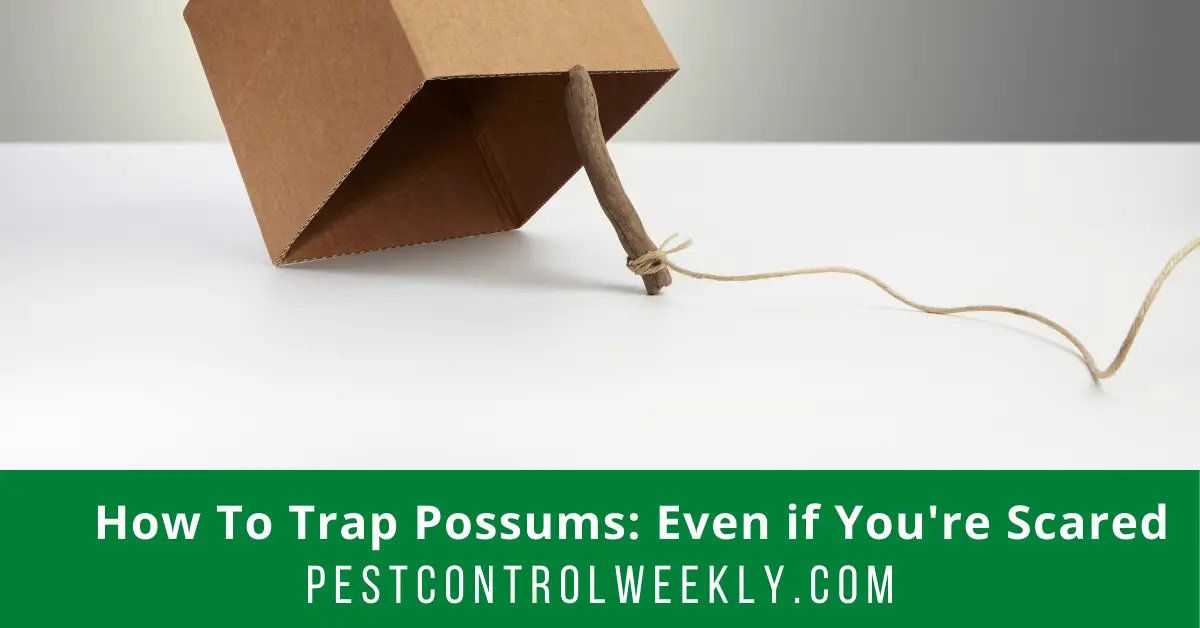Perhaps, you feel they have messed up your garden. Or maybe they have created a stinging toilet in your attic or yard.
Trapping an opossum can be a scary endeavor for non-experienced trappers. However, they’re a few things you need to know:
- Types of possum traps
- How to set possum traps
- Disposing of a trapped possum
- The best bait for possums traps
We’ll cover those four essentials in this guide to help you trap these creatures in your yard or garden. But before we get ahead of ourselves, we thought you should know this first.
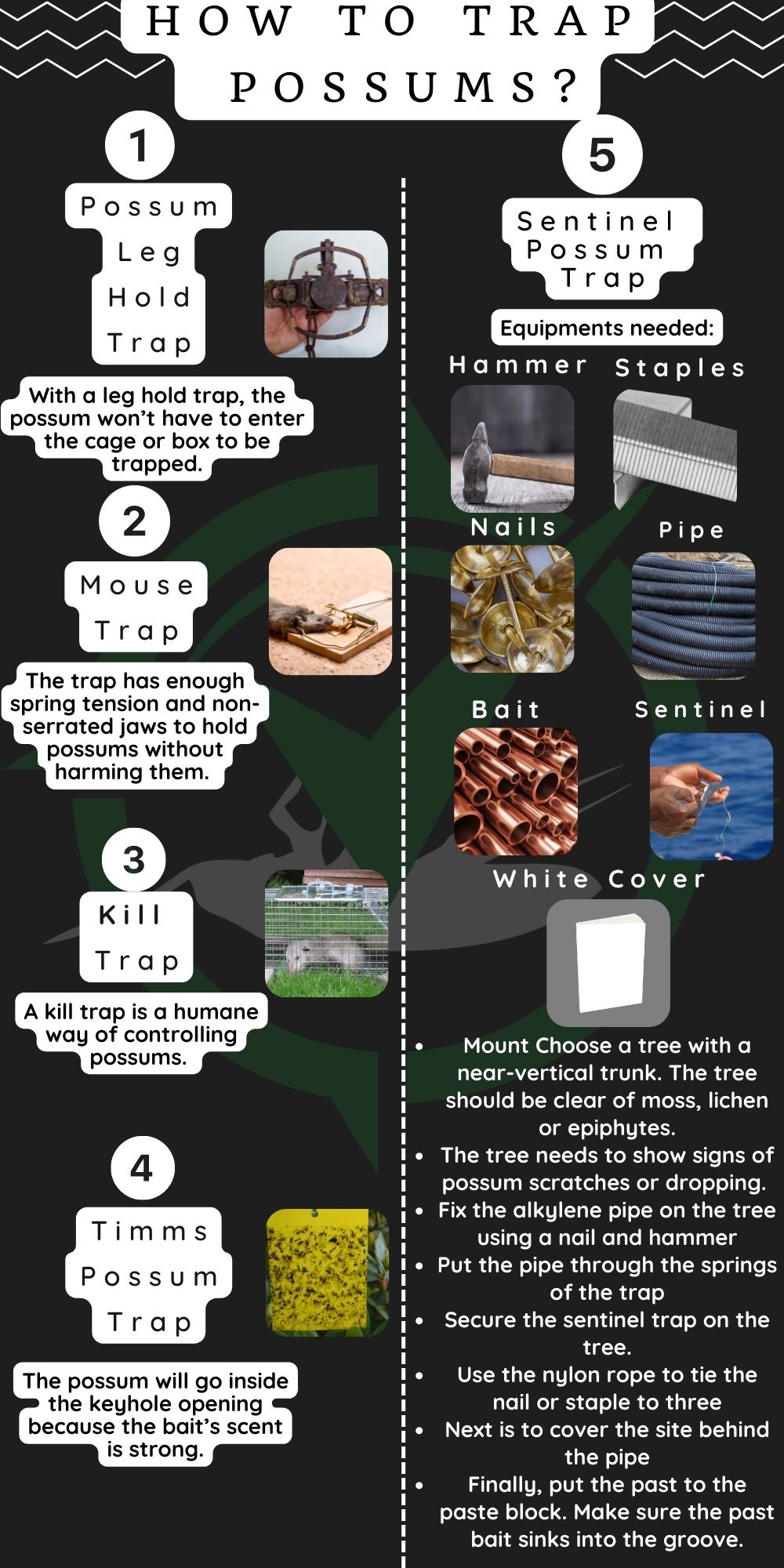
What Is a Possum Trap ?
There’s no specific trap for catching a possum, but we have different traps for small to large-sized animals like raccoons, ferals, cats, and possums.
A spring-loaded mechanism is usually attached to the bait platform to trap an animal. Each trap features a giant rectangular metal made of solid steel bars meshed together.
Inside, you’ll see a spring attached to the platforms. The spring is usually connected to the door. The platform’s purpose is to place the bait that will attract the possum into the trap of the platform bait.
Then, its weight will trigger the spring to trip and close the door. That’s how animals like possums, raccoons, and skunks are trapped.
When the door is closed from the outside, it stops the possums from escaping. The galvanized steels are too strong to prevent even the biggest animal from tampering with the door.
In most cases, the trapped opossum will be too scared and confused to try and wrestle with the trap. That’s how an opossum trap works. Besides this measure, you can also use natural deterrents to deter opossum way.
Types of Possum Traps
There are three types of traps that you can use to catch a possum. Depending on which trap you use, make sure you stick with the Wildlife Act, which stipulates that you need to check the animal within 12 hours after you have it. Here are the different traps you can use to trap possums:
Possum leg-hold trap
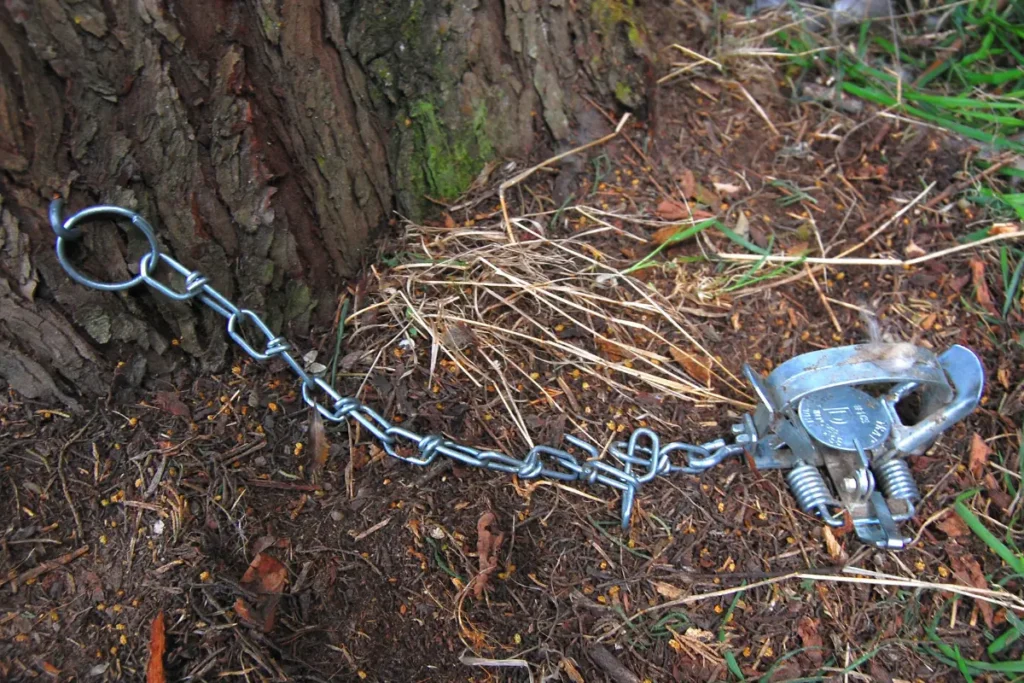
Several types of holding traps are used to trap possums because they are effective. With a leg hold trap, the possum won’t have to enter the cage or box to be trapped.
The Aunthenzo Mouse Trap Indoor
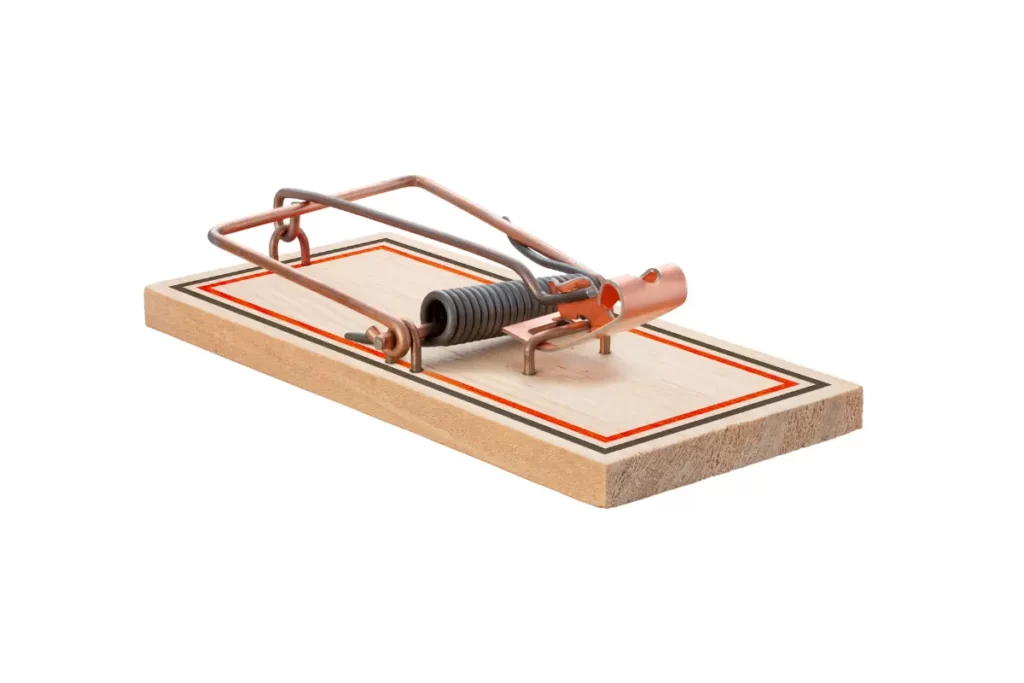
If you are looking for a leg hold trap, we recommend this trap because it’s small, light, and comes in 6packs. You can place the leg-hold trap at various possum entries such as the attic, garbage, the roof, fence, or the garden.
The trap has enough spring tension and non-serrated jaws to hold possums without harming them. The success of this trap depends on where you place it.
So make sure to choose excellent trap sites where it will be easier to catch a possum. Excellent trap sites are tree barks and sites where possums visit often.
How to set a leg-hold trap for an Opossum
When setting the trap, ensure it’s level and steady. The trap needs to be set a hand width from the tree base. If you live in the Kiwi zones, place the leg-hold possum trap at least 30mm off the ground on a raised set.
For weke birds, you need to set it at 700mm. Bear in mind that a raised set has no standard placement, and it can take many forms. Besides that, a raised set can also be a ramp created from fallen forest debris.
When using a raised set, ensure that the trap chain is well-secured and long enough. That way, it will be easier for the possum to fall to the ground without much suspension.
Well put possum trap doesn’t need to be lured. But if you have to put a lure, ensure to rub it on the tree trunk. The possum lure shouldn’t be applied to the trap plate because it may be caught on the head instead of the leg.
The possum trap lines are set at least 100m apart in the forest or wild and spaced between 20m to 40m intervals depending on the possum infestation.
When the trap line has been set, you must work on the trap until the capture rate drops to one possum per 10 trap nights.
Inspect the trap every month and handle the captured possum with care because they can injure themselves or bite you with their claws and teeth.
Possum Kill Traps
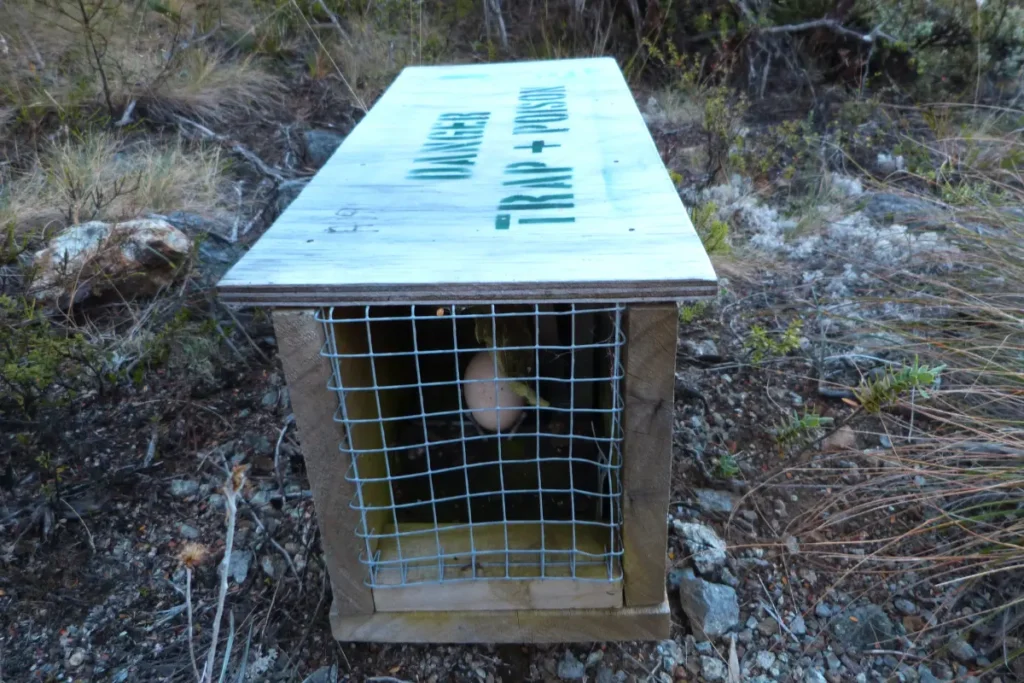
A kill trap is a humane way of controlling possums. When used well, this method is effective in any environment.
You’ll find a lot of kill traps online that you can safely use to control these animals. One of the commonly used possums kill traps is the Timm possum trap.
Timms Possum Trap
A timm trap is a box trap consisting of lightweight polyethylene plastic. The color which offers a visual cue is effective in luring the possum.
The possum will go inside the keyhole opening because the bait’s scent is strong. You can set the Timms trap on the ground or attach it to the trees, fence, attic, or roof.
How Do You Set a Timms Possum Trap?
A timm trap is set overnight with a piece of fresh fruits such as apple, oranges, or carrots as bait. You can also bait the trap with other foods that possum eat.
- The possum bait should be firm and replaced every two days. Besides that, you need to add a mixture of cinnamon, icing sugar, and flour. They should be sprinkled around the trap and on the fruits to make it enticing.
- Never use meat or fish as bait because they can attract pets such as cats or dogs nearby. To prevent the cat from going in there, you need to let it sniff or check the trap house. The loud banging will scare the cat or dog away. The bang comes from a trap springing.
- Once the possum takes the bait and trips the striker bar, the neck is forced upward into the confined upper part of the keyhole opening. Opossum brain arteries are compressed, and the creature dies instantly.
- Turn the trap in the upside-down position and put the bait into the trigger wire. The trap needs to be placed on the ground right away, and the wire pegs should be pushed through the holes on the two sides of the basic rim to secure the trap in the correct position.
- Next, hold the trap firmly with one hand, pulling the nylon card until you feel the striker bar has come into the correct position.
Where to Place The Timms Possum Trap
Place it on the level ground where possums pass a lot. It should be away from children and pets. Consistently unset the trap every morning and reset it at night.
When releasing the trap, it’s essential to keep the tension on the nylon cord with one hand. Then you can release the striker bar with one hand and let the nylon cord drawback inside the trap slowly.
To remove a dead possum, you need to pull the nylon cord like you did while setting the trap. Pull it until you set the possum free.
Sentinel Possum Trap
These traps are made from aluminum and steel to withstand harsh weather conditions. They are placed on tree trunks to avoid interference with other animals.
The Department of Conversation uses this sentinel possum trap because of its sturdiness and effectiveness. Most importantly, withstanding harsh conditions while ensuring effective maintenance control.
Once the sentinel possum trap is in position, place a white cover flute cover over the top of the trap. Here are the tools you need to set up a sentinel possum trap:
- Hammer,
- Staples and nails
- Nylon rope
- Alkathene pipe
- Bait
- Sentinel trap
- White cover
How to set up a Sentinel Possum Trap
- Mount the sentinel trap on a good tree that is 1.2 meters off the ground. Choose a tree with a near-vertical trunk. The tree should be clear of moss, lichen or epiphytes.
- The tree needs to show signs of possum scratches or dropping. Also, check for small insects that may attract possum to the tree.
- Fix the alkylene pipe on the tree using a nail and hammer
- Put the pipe through the springs of the trap
- Secure the sentinel trap on the tree using a nail and a hammer
- Use the nylon rope to tie the nail or staple it to three
- Next is to cover the site behind the pipe
- Finally, put the past to the paste block. Make sure the past bait sinks into the groove.
The cover will guide the possum into the kill zones. Kindly watch the video below to learn how to set up a sentinel possum trap.
Additional Tips
You can adjust the sensitivity of the trigger action by bending the bait rod where it contacts the cross rod. If you bend towards the front of the trap, release action will be more sensitive.
Sometimes the cover can be blown away by the wind causing safety issues. This means any animal getting close to the trap either from the top or side will set the trap off, and it won’t be caught or caught by the leg.
To prevent this, you can use a 5 mm nylon cable to tie across the lower section of the cover. To remove a dead possum, you’ll need to lift the handle, and the possum will fall off the ground, and you can go through the process again of resetting the trap.
The main benefit of a sentinel possum trap is that it can reduce the possum population throughout the year compared to other methods.
Live Possum Traps or Possum Cage Trap
These kinds of traps are used in Urban areas where the chances of catching a possum are high. Live traps are also called live capture traps or cage traps.
These traps are placed closed to damage trees or plants where the opossum frequently passes a lot. The trap needs to be far away from trees.
Otherwise, the opossum will climb the tree instead of going into the cage. The cage trap has to be placed on firm ground. Make sure the door closes well when triggered.
Choose a live possum trap that’s 30 to 40 inches in length and 12 inches in height. This is enough room for the possum to fit into the trap and enter without suspicion. Most possum cage traps will have 1 or 2-door models:
- The one-door model is more accessible for big animals to enter. Most pest control experts love it because it offers the best bait protection.
- The two-door model has a higher catch rate because a living animal is reassured that there’s no way out. This is best used on suspicious animals.
How to set alive (or cage) possum trap
The best area to set a live trap is near the opossum’s den, which can be in your attic, roof, yard, or forest, or garden. If you can’t locate the den, place the trap where most damage or activities will occur. Here are the instructions you need to follow:
Place the trap on a level surface
- Keep the trap out of sunlight to prevent overheating
- Make sure to stabilize your trap by placing two blocks of bricks on top. This will prevent the opossum from knocking over the trap
- If the opossum is living under the porch, place a trap 3 to 5 feet outside the entrance
- Bait the possum cage trap with apples, kiwi fruits, fish, or canned pet food. The bait needs to be wedged between the trigger plate and the bottom of the trap to ensure the door closes.
- Put the bait at the far end of the trap behind the trigger plate. So that when the animals come to feed on the bait, it activates the trigger plate and is trapped. Once you have trapped the opossum, put a towel over the cage to keep the animal calm.
- Finally, make sure to check your trap within 24 hours. The longer you keep possums in the trap, the hungrier, nervous and thirsty the animal gets.
Disposing of Trapped Possums
The first thing is to check the possum trapping or relocation laws in your area. For instance, it is illegal to release possums in New Zealand. Every possum in New Zealand must be well disposed of.
South Australia has the National Park and Wildlife Act of 1972, which protects possums against hunting, killing, and other activities that may harm the animal. In Australia, you should only trap an opossum if it’s living in your building, especially the common brushtail possum.
Relocating a possum is one way of releasing the animal safely into its natural habitat away from home. You are always free to kill the animal or relocate it depending on the local area.
Relocating the animal is safe. If you want to relocate the animal, make sure you handle the animal with a proper safety kit like gloves. An opossum can spread a lot of infectious diseases through biting or scratching.
Read More: Did you know that you can get diseases from possum poop?
Best time to relocate possums
The best time to relocate the animal is during the night. Possums are not going to be in their best shape when they are released during the day. What’s more, they will have a hard time finding shelter.
Ensure that you relocate the animal to an area where it can find lots of shelters. For instance, if you live an opossum on the road, it will have a hard time finding shelter, and it may get knocked down by a car. Those who don’t know what to do with a trapped opossum can always call pest control experts or pest control companies to help you trap and dispose of the possum.
Are You Ready to Trap Possums
Although possums don’t top the list of wildlife pests like cockroaches, rats, and raccoons. They are destructive once they have found a place to forage food.
Trust me. It can be a headache living with these creatures in your backyard or garden. Not only will they eat your food, but they will also leave poop everywhere.
Besides that, their poop stinks to the heavens, and you can get diseases when you touch their poop. In other words, these creatures can put your family’s and pet’s health at risk when left to roam around. If you are unsure about trapping them, you may need a wildlife control expert who can get rid of them in your backyard.
